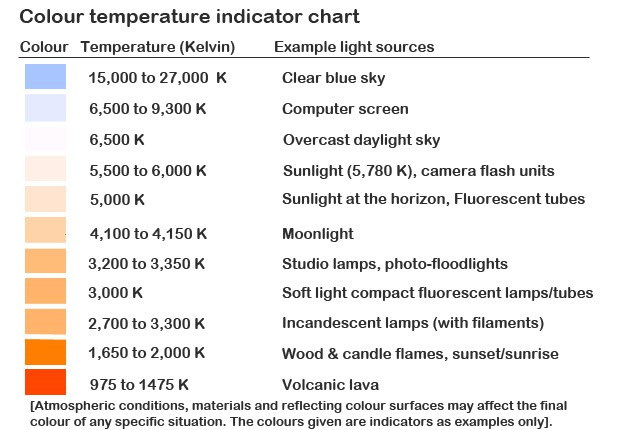![]()
Colour temperature
When a light source radiates visible light it has its own colour property. In order for photographers to be able to discuss particular types of light they have recognised that some form of comparative scale is required. Light is commonly (but not exclusively) created by thermal sources – hot objects. In fact thermal sources exhibit a range of common colours that can be conveniently measured. So we have come to relate light colour to ‘colour temperature’.
There is more than one way to measure ‘colour temperature’. However, a scale relating to absolute temperatures provides the best comparison scale for photographers. We use the scale of temperature called the Kelvin Scale (after Lord Kelvin ![]() the mathematical physicist and engineer). The Kelvin
the mathematical physicist and engineer). The Kelvin ![]() is a unit measurement of temperature. Kelvins are usually designated with a capital K – so we say 5,000K meaning five thousand Kelvins. Zero (0)K is equivalent to -273.15 degrees Celsius (absolute zero). The scale extends to measure the hottest objects in the universe, stars.
is a unit measurement of temperature. Kelvins are usually designated with a capital K – so we say 5,000K meaning five thousand Kelvins. Zero (0)K is equivalent to -273.15 degrees Celsius (absolute zero). The scale extends to measure the hottest objects in the universe, stars.
The Kelvin is used for the calibration of ‘Colour temperature’ for light sources. Calibration is based upon an idealised radiator of light (called a black body radiator ![]() ). The principle is that the black body emits a specific colour of light for a given temperature of the radiator. For any known temperature of the idealised radiator the colour of light will always be the same. Colour matches for known colours allows photographers to match colour temperatures to standardise light-colour and light-sources.
). The principle is that the black body emits a specific colour of light for a given temperature of the radiator. For any known temperature of the idealised radiator the colour of light will always be the same. Colour matches for known colours allows photographers to match colour temperatures to standardise light-colour and light-sources.
An example might help understanding of the principles involved. If we heat up a metal bar the bar exhibits a range of colour emissions as it heats up. First, it goes a very dull reddish colour. More heat and it starts bright red emission. Increased heat will take it into orange and onto yellow. Next the bar turns slightly green then through to white. These thermal emissions indicate how the colour temperatures are defined.
In scientific terms the colour matches between particular colour temperatures and the Kelvin scale are highly accurate. This allows the colour of light to be matched for specific Kelvin measurements. The use of the Kelvin scale to match light sources like photographic lights, daylight and other sources is very useful. The White Balance in a camera can be adjusted against known colour temperature standards for example. Photographic lights themselves can be built to emit known colours at specific colour temperatures. Thus, the same model always emits the same light colour – making standard manufacturing possible.
The chart below shows some examples. Click the chart to view it full sized.

The chart shows the different colours generated by thermal light sources.
View large.
While the colour chart above is useful as an example, it is not a scientific colour-match chart. The colours will vary on un-calibrated computer screens – the chart is simply indicative. With respect to colours in the environment they may vary from the chart too. The idealised model of the black-body radiator is a theoretical model. It’s use is for laboratory conditions. In the open air the weather, the angle of the Sun, the moisture in the air and other factors including airborne dust, local biology and geology can all affect the local light colour. Inside, the colours of the walls and other objects can also affect colour.
In general the accurate determination of colour temperature in the field must remain a scientific pursuit. However, the use of Standard Kelvin measurements are useful. The use of standard colour temperatures in the post processing of RAW files is very useful. Image editing applications use the the Kelvin scale colour temperatures for certain standard tasks.
